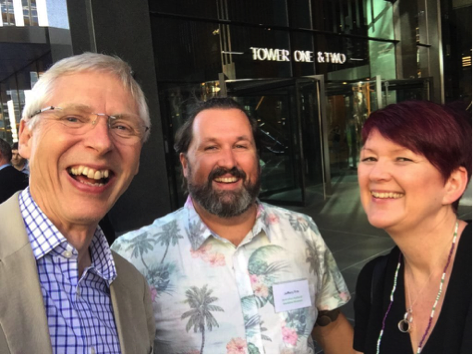On Monday 28th of January 2019 at the Society of Antiquaries of London, Julian Bickersteth was elected as President of the International Institute for Conservation of Historic and Artistic Works (IIC). This is the first time that an Australian has held this role. To recognise his achievement, Nick Flood met with Julian earlier this month to talk about his election and what this means to him and for conservators in Australia.
Nick: Julian can you tell us a bit about your background and career in conservation?
Julian: I am always fascinated to hear how my colleagues have reached our profession because many of us have not been born with the unerring desire to become conservators. That means many of us have tried other things along the journey, making the profession the richer for that wider experience. In my instance, I read theology at Oxford University, got a job in a merchant bank in London, then spent 18 months working at Timbertop (the outward-bound part of Geelong Grammar School). That experience cured me of banking and hooked me on Australia. I toyed with becoming a harpsichord maker and then a furniture maker before settling on furniture conservation. I trained at West Dean College back in the UK, worked in London privately for a couple of years and then was appointed to the position of the first furniture conservator at the Powerhouse Museum in Sydney. I was there for four years during the 1980s, a formative time not only for me but for Australian museological more broadly. Then in 1988 came the Bicentenary and I left the Powerhouse to establish International Conservation Services (initially as Campbell Conservation).
Nick: What has been your involvement with the AICCM and IIC over the years?
Julian: Colin Pearson was a guide and mentor to many conservators who didn’t go through his Canberra course. I was lucky enough to be one of them and he instilled in me at an early stage the advantage of being part of the international conservation community. So, while I was undertaking various AICCM roles in the 1980s and 90s (Treasurer and Editor of The Bulletin) I was also playing a part in IIC. This led to me chairing the local committee for the very successful IIC Congress in Melbourne in 2000. From there I spent six years on the IIC Council and thought I was done, when Jerry Podany (IIC President at the time) called me from the Getty and asked me to stand for Vice-President and undertake some very specific roles. This led to my becoming the first Director of Communications, a role I have held for the last six years working very closely with the inspirational immediate past IIC President Sarah Staniforth. I was elected IIC President in January this year.

Nick: Can you paint a picture of what a day in the life of the IIC President is like?
Julian: As with many voluntary organisations the time requirements are lumpy. These centre round the three Council meetings held during the year, two of which are in London and one of which is generally elsewhere. Last year’s meeting was held in Turin to coincide with the IIC Congress and the previous two in Rome and Doha. So, the time (and cost — IIC pays no travel expenses) commitment is about three weeks a year overseas. What I had not exactly allowed for are all the invitations that come to the President to be present at international meetings around the world. These meetings are really important for IIC to be part of and I’m lucky that I can share attendance with my fellow Councillors. Then of course there are the daily emails that flow to ensure the organisation runs smoothly, though in reality the vast part of this is looked after by the IIC Secretariat in London headed by our Executive Director Sarah Stannage.

Nick: What has sustained your involvement in these professional bodies?
Julian: Colin Pearson was absolutely right that I have had a much more fulfilling conservation career through playing an active part in the national and international conservation community, through the friends I have made, the places I’ve been, and what I have learnt and been able to share as a conservator. Key to IIC’s growth is creating a participatory rather than a transactional membership organisation. What that means is that joining the IIC is about being part of a worldwide organisation in which members share common values and a common passion to preserve cultural heritage. AICCM is no different and as most conservation occurs at grassroots level national organisations are better able to serve this area than international ones. The international component therefore is not instead of but in addition to national membership as it is where you can share worldwide wisdom bringing a broader perspective to the work that people do in their own countries and a much bigger pool of expert knowledge and inspiration to draw upon.
Nick: What does your election mean for conservation in Australia?
Julian: I really want to reiterate the value of being connected with international organisations such as IIC. The benefits for me have been immeasurable in terms of how they have helped my own growth as a conservator. Many Australian conservators have played and continue to play illustrious international roles, but my election I hope will allow me to affirm and showcase around the world the extraordinary work that is undertaken in this country, and with it inspire others to play similarly active roles. I will always be pleased to hear from anyone seeking to understand how they could do this.